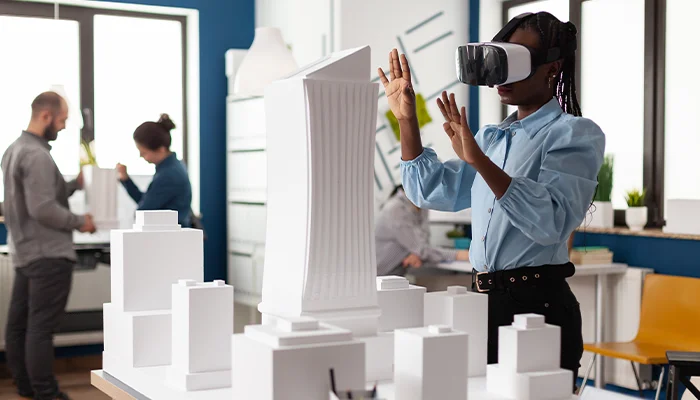AI in Architecture Benefits, Use Cases, Examples, and Challenges

JUN, 7, 2024 16:30 PM
AI in Architecture Benefits, Use Cases, Examples, and Challenges
Artificial Intelligence (AI) has made significant strides across various industries, and architecture is no exception. As the architectural landscape evolves, AI is becoming an integral part of the design, planning, and construction processes. This comprehensive guide explores the benefits, use cases, real-world examples, and challenges associated with AI in architecture, highlighting how PerfectionGeeks Technologies can help integrate these innovations.
The Role of AI in Architecture
AI encompasses machine learning, neural networks, computer vision, and other technologies that enable machines to perform tasks typically requiring human intelligence. In architecture, AI can analyze large datasets, generate design options, optimize building performance, and even predict future trends, thereby transforming how architects conceptualize and execute projects.
Evolution of AI in Architectural Design
The adoption of AI in architecture has evolved from basic automation of repetitive tasks to complex generative design and predictive analytics. Early applications focused on automating drafting and documentation, but recent advancements have introduced AI-driven design tools that can create multiple design iterations based on predefined criteria, optimize energy efficiency, and enhance building safety.
Benefits of AI in Architecture
Enhanced Design Efficiency
AI streamlines the design process by automating repetitive tasks such as drafting, rendering, and creating detailed plans. This allows architects to focus more on creative aspects and complex problem-solving. AI algorithms can quickly generate multiple design alternatives based on specific parameters, enabling architects to explore various options and select the most optimal solution.
Improved Accuracy and Precision
AI-powered tools reduce human error by ensuring precise calculations and measurements. For instance, AI can help in generating accurate construction documents and detailed floor plans, minimizing the risk of costly mistakes during the construction phase. This precision is particularly crucial in large-scale projects where even minor errors can lead to significant delays and budget overruns.
Optimized Building Performance
AI can analyze vast amounts of data to optimize building performance in terms of energy efficiency, sustainability, and occupant comfort. Machine learning algorithms can predict energy consumption patterns, optimize HVAC systems, and suggest design modifications to enhance natural lighting and ventilation. This results in buildings that are not only more efficient but also environmentally friendly.
Cost and Time Savings
By automating various aspects of the design and construction process, AI helps in reducing project timelines and overall costs. AI-driven project management tools can optimize scheduling, resource allocation, and risk management, ensuring that projects stay on track and within budget. This efficiency is particularly beneficial in the competitive construction industry where time and cost savings are paramount.
Enhanced Visualization and Virtual Reality
AI enables advanced visualization techniques such as virtual reality (VR) and augmented reality (AR), allowing architects and clients to experience designs in immersive 3D environments. This enhances communication and collaboration, as stakeholders can visualize the final outcome before construction begins. VR and AR also facilitate better decision-making by providing a realistic view of the design.
Predictive Maintenance and Facility Management
Post-construction, AI can be used for predictive maintenance and facility management. By analyzing data from sensors and IoT devices, AI can predict when building systems are likely to fail and schedule maintenance accordingly. This proactive approach reduces downtime, extends the lifespan of building systems, and ensures a comfortable environment for occupants.
Use Cases of AI in Architecture
Generative Design
Generative design is one of the most promising applications of AI in architecture. Using algorithms, architects can input design parameters such as spatial requirements, materials, and budget constraints. The AI then generates multiple design options that meet these criteria. This approach allows for innovative and optimized design solutions that might not be possible through traditional methods.
Smart Building Systems
AI is integral to the development of smart buildings that use IoT devices and sensors to monitor and control various building systems. AI algorithms analyze data from these sensors to optimize lighting, heating, ventilation, and security systems in real-time. This not only enhances occupant comfort but also significantly reduces energy consumption.
Urban Planning and Development
In urban planning, AI can analyze demographic, environmental, and economic data to inform better decision-making. AI-driven simulations can predict the impact of new developments on traffic, pollution, and local ecosystems. This helps urban planners design sustainable and efficient urban spaces that accommodate population growth and enhance quality of life.
Construction Automation
AI-powered robots and drones are revolutionizing the construction industry. Robots can perform tasks such as bricklaying, welding, and concrete pouring with high precision and efficiency. Drones are used for site surveys, progress monitoring, and safety inspections. These technologies improve construction quality, reduce labor costs, and enhance safety on construction sites.
Historical Building Preservation
AI is also used in the preservation and restoration of historical buildings. Machine learning algorithms can analyze historical data and architectural styles to create accurate digital models of heritage structures. These models assist in planning restoration projects and ensuring that renovations are in line with the original architectural intent.
Real-World Examples of AI in Architecture

The Edge, Amsterdam
The Edge, an office building in Amsterdam, is often cited as one of the smartest buildings in the world. It uses AI to create an adaptive environment that maximizes energy efficiency and occupant comfort. AI systems control lighting, heating, and ventilation based on real-time data from sensors throughout the building. The result is a highly efficient workspace with minimal environmental impact.
Autodesks Project Refinery
Autodesks Project Refinery is an example of generative design in action. This tool uses AI to generate multiple design options based on specified goals and constraints. Architects can explore various design scenarios and select the best option that meets their criteria. Project Refinery has been used in projects ranging from office layouts to urban planning.
Shanghai s AI-Driven Urban Planning
Shanghai has implemented AI in its urban planning initiatives to manage rapid urbanization. AI algorithms analyze data on traffic, population density, and environmental factors to inform the development of new urban areas. This approach ensures that infrastructure development is sustainable and efficient, addressing the challenges of a growing metropolis.
WeWorks Space Optimization
WeWork uses AI to optimize the design and layout of its coworking spaces. By analyzing data on how occupants use the space, AI algorithms suggest layout modifications that enhance productivity and comfort. This data-driven approach ensures that the design meets the needs of the users and maximizes the utilization of available space.
Challenges of Implementing AI in Architecture
High Initial Costs
The implementation of AI in architecture requires significant upfront investment in software, hardware, and training. Small and medium-sized firms may find it challenging to allocate the necessary resources for adopting AI technologies. However, the long-term benefits of increased efficiency and cost savings can justify the initial expenditure.
Data Privacy and Security
AI relies on vast amounts of data to function effectively. Ensuring the privacy and security of this data is crucial, especially in the context of smart buildings and urban planning where sensitive information is involved. Architects and developers must implement robust data protection measures to prevent breaches and comply with relevant regulations.
Complexity and Integration
Integrating AI into existing workflows and systems can be complex. Many architecture firms use legacy software and processes that may not be compatible with new AI technologies. Ensuring seamless integration requires careful planning, customization, and ongoing support. This complexity can pose a barrier to widespread adoption.
Ethical Considerations
The use of AI in architecture raises ethical considerations related to job displacement, decision-making, and bias. For instance, the automation of certain tasks could lead to job displacement for some professionals in the architecture and construction industries. It's essential to address these ethical concerns by promoting reskilling and upskilling initiatives, ensuring that the workforce can adapt to new roles and responsibilities created by AI integration.
Decision-Making and Bias
AI systems can sometimes perpetuate existing biases present in the data they are trained on. In architecture, this could manifest in design decisions that do not adequately consider the needs of diverse user groups. It's crucial to ensure that AI algorithms are developed and trained on diverse, representative datasets to avoid biased outcomes and promote inclusive design solutions.
Regulatory Compliance
The use of AI in architecture must comply with various regulations and standards, particularly concerning data privacy and building codes. Navigating the regulatory landscape can be challenging, especially in regions with stringent regulations. Ensuring compliance requires ongoing monitoring and adaptation of AI systems to meet evolving legal requirements.
Resistance to Change
The architectural industry has a long history and established practices that can sometimes be resistant to change. The adoption of AI requires a cultural shift within organizations, embracing new technologies and methodologies. Overcoming resistance to change involves demonstrating the tangible benefits of AI and fostering a culture of innovation and continuous improvement.
The Future of AI in Architecture
Advancements in Generative Design
Generative design is expected to become even more sophisticated, allowing architects to create highly optimized and innovative designs that push the boundaries of traditional architecture. Advances in AI algorithms and computing power will enable more complex simulations and design iterations, leading to groundbreaking architectural solutions.
Integration with IoT and Smart Cities
The integration of AI with the Internet of Things (IoT) and smart city initiatives will revolutionize urban planning and building management. AI will analyze data from a vast network of connected devices to optimize city infrastructure, enhance sustainability, and improve the quality of life for urban residents. Smart buildings will become integral components of smart cities, leveraging AI to create intelligent, responsive environments.
Personalized Architecture
AI has the potential to enable personalized architecture, where buildings are designed to meet the unique needs and preferences of individual occupants. By analyzing data on user behavior and preferences, AI can create customized living and working spaces that enhance comfort, productivity, and well-being. This personalized approach could redefine how we interact with our built environment.
Enhanced Collaboration and Co-Creation
AI will facilitate enhanced collaboration and co-creation among architects, clients, and other stakeholders. Virtual reality (VR) and augmented reality (AR) will play a significant role in this process, allowing stakeholders to interact with and modify designs in real-time. AI-powered tools will streamline communication and decision-making, ensuring that projects meet the diverse needs and expectations of all involved parties.
Sustainable and Resilient Architecture
Sustainability and resilience will be at the forefront of future architectural design, driven by AI's ability to optimize resource use and predict environmental impacts. AI will help architects design buildings that are energy-efficient, environmentally friendly, and resilient to climate change and other challenges. This focus on sustainability will contribute to the creation of a more sustainable and resilient built environment.
Conclusion
AI is poised to revolutionize the field of architecture, offering numerous benefits, innovative use cases, and transformative potential. From enhancing design efficiency and accuracy to optimizing building performance and facilitating smart urban planning, AI is reshaping how architects and planners approach their work. Real-world examples demonstrate the significant impact of AI on architectural practices, highlighting the possibilities for future advancements.
However, the implementation of AI in architecture also presents challenges, including high initial costs, data privacy concerns, integration complexity, ethical considerations, and regulatory compliance. Addressing these challenges requires a thoughtful approach, robust data protection measures, ongoing training, and a commitment to ethical practices.
PerfectionGeeks Technologies is at the forefront of integrating AI into architectural processes, offering expertise and innovative solutions to help architects and developers harness the power of AI. By embracing AI, the architectural industry can unlock new levels of creativity, efficiency, and sustainability, paving the way for a future where buildings are more intelligent, responsive, and attuned to the needs of their occupants and the environment.
As we look to the future, the potential of AI in architecture is boundless. By continuing to explore and adopt AI-driven technologies, architects and planners can create spaces that are not only functional and beautiful but also sustainable, resilient, and deeply connected to the needs of society. The journey towards an AI-enhanced architectural future is just beginning, and the possibilities are truly inspiring.




Strategy
Design
Blockchain Solution
Development
Launching
Testing
Maintenance
Contact US!
India

Plot 378-379, Udyog Vihar Phase 4 Rd, near nokia building, Electronic City, Phase IV, Sector 19, Gurugram, Haryana 122015
Copyright © 2026 PerfectionGeeks Technologies | All Rights Reserved | Policy
Strategy
Design
Blockchain Solution
Development
Contact US!
India 
Plot 378-379, Udyog Vihar Phase 4 Rd, near nokia building, Electronic City, Phase IV, Sector 19, Gurugram, Haryana 122015
USA 
1968 S. Coast Hwy, Laguna Beach, CA 92651, United States
Copyright © 2026 PerfectionGeeks Technologies | All Rights Reserved | Policy


